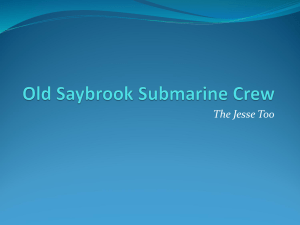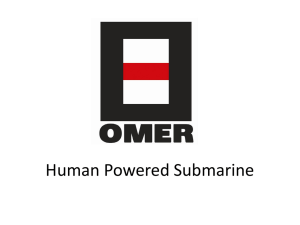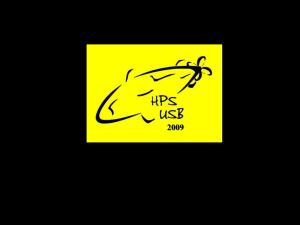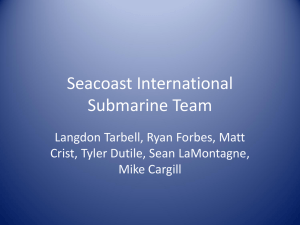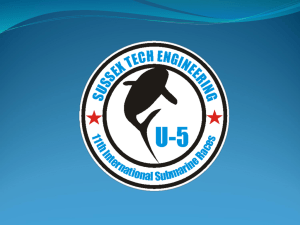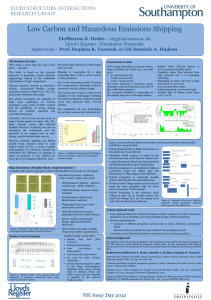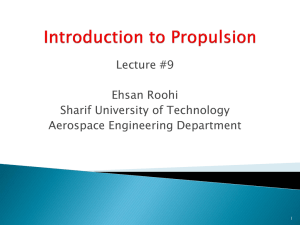SHIP PROPULSION SYSTEM
advertisement
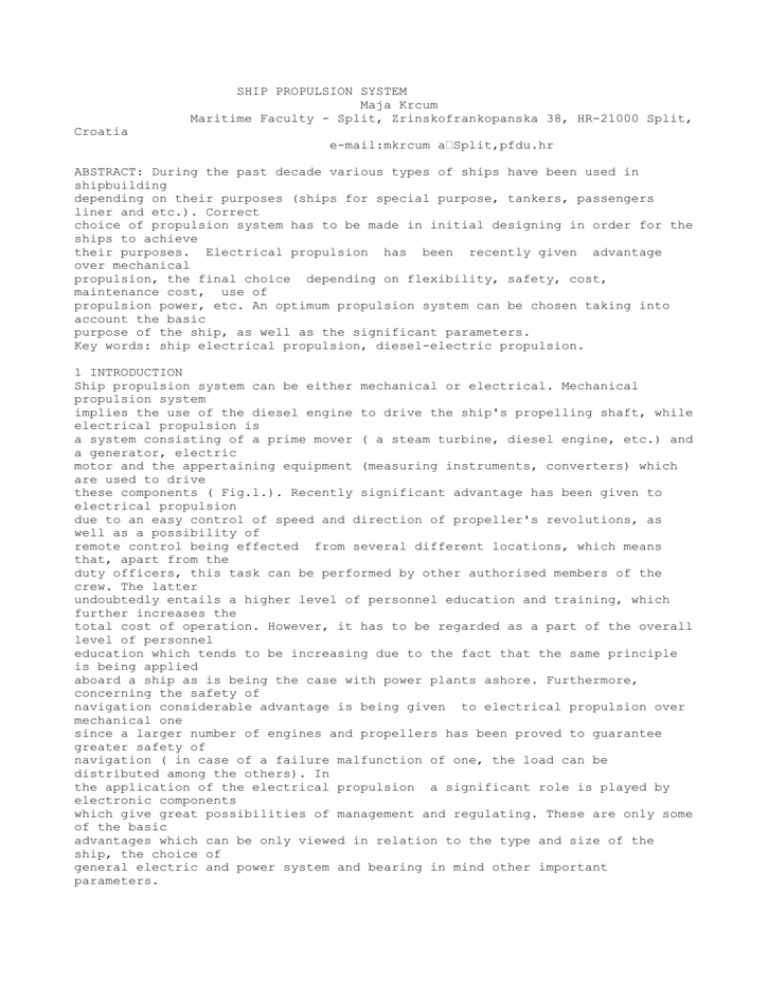
SHIP PROPULSION SYSTEM Maja Krcum Maritime Faculty - Split, Zrinskofrankopanska 38, HR-21000 Split, Croatia e-mail:mkrcum a•Split,pfdu.hr ABSTRACT: During the past decade various types of ships have been used in shipbuilding depending on their purposes (ships for special purpose, tankers, passengers liner and etc.). Correct choice of propulsion system has to be made in initial designing in order for the ships to achieve their purposes. Electrical propulsion has been recently given advantage over mechanical propulsion, the final choice depending on flexibility, safety, cost, maintenance cost, use of propulsion power, etc. An optimum propulsion system can be chosen taking into account the basic purpose of the ship, as well as the significant parameters. Key words: ship electrical propulsion, diesel-electric propulsion. 1 INTRODUCTION Ship propulsion system can be either mechanical or electrical. Mechanical propulsion system implies the use of the diesel engine to drive the ship's propelling shaft, while electrical propulsion is a system consisting of a prime mover ( a steam turbine, diesel engine, etc.) and a generator, electric motor and the appertaining equipment (measuring instruments, converters) which are used to drive these components ( Fig.l.). Recently significant advantage has been given to electrical propulsion due to an easy control of speed and direction of propeller's revolutions, as well as a possibility of remote control being effected from several different locations, which means that, apart from the duty officers, this task can be performed by other authorised members of the crew. The latter undoubtedly entails a higher level of personnel education and training, which further increases the total cost of operation. However, it has to be regarded as a part of the overall level of personnel education which tends to be increasing due to the fact that the same principle is being applied aboard a ship as is being the case with power plants ashore. Furthermore, concerning the safety of navigation considerable advantage is being given to electrical propulsion over mechanical one since a larger number of engines and propellers has been proved to guarantee greater safety of navigation ( in case of a failure malfunction of one, the load can be distributed among the others). In the application of the electrical propulsion a significant role is played by electronic components which give great possibilities of management and regulating. These are only some of the basic advantages which can be only viewed in relation to the type and size of the ship, the choice of general electric and power system and bearing in mind other important parameters. Fig. l. Diagram of an electrical propulsion system 2 SELECTION OF THE PROPULSION SYSTEM Electrical propulsion implies three levels of conversion: generator - electric motors - static converters. Electrical power sources feeding the propelling shafts can be a storage battery, a combination of diesel generator and a storage battery or combustible cell. Electric generators are driven by means of turbines and diesel-engines (turbogenerator and diesel generator). The so-called combined propulsions have been recently employed. They include an electric motor supplied from a separate source being added to the direct propulsion. This electric motor gives additional power to the propelling shaft, otherwise driven by a turbine or diesel engine. 2.1 Parameters important for the dimensioning of propulsion engines Changes in the ship's resistance caused by the change of speed, waves, wind etc. further lead to a change in the propeller's speed and, consequently, the drive power. The ship's propulsion system has to adapt to these changes in load. In order for the electrical propulsion engines to be properly dimensioned, extreme points of engine driving process have to be taken into account. The maneuvering of reversal of the engine, whether it is done for stopping or changing from ahead to astern, is an important consideration concerning the safety of ship while landing, as well as avoiding accidents at see. While maneuvering or altering the ship's direction the ship has to be slowed down and the ship's mass in motion, the propeller and the shaft's mass, as well as mass of water pressing against the shaft and the propulsion rotor mass, have to be brought to a stop, then reversed in the opposite direction and accelerated. The operational processes required at such maneuvering have been analysed and various methods for calculating the propulsion system moments in particular stages have been elaborated and developed. The engine reversal is determined by the ship's motion (1) and the equation expressing the propulsion system (2): dv (1 dt ) dw J . d = M,. - MP - M• (2) t m - being the ship's mass and the additional engine mass, v - ship's speed, t time, F - propeller's driving force, R - ship's resistance, J - inertia moment of rotating masses and the additional engine mass, w - angle speed , M5. - engine torque, MP - propeller moment, M• - moment of propeller friction. The change in (1) and (2) is tested on a certain model and the results of measuring are shown by means of curves, where for different constant speeds of propeller rotation the change in the propeller's moment due to its reversal are observed. The electrical propulsion is performed by directional or alternating engines. The employment of silician converters has created hybrid propulsion systems where alternating generators are used and the propulsion engines are directional. By semi-conductor appliances the gap of the engines using directional current and those using alternating current has been bridged, which is convenient since it ensures the use of alternating generators, at the same time retaining the good performance of directional engines speed control. 2.2 Driving of the ship's propeller by a directional current motor In case of directional current drive the adjustment to the change of load is safely achieved by these engines very characteristic: the fact that, when loaded, they give the propeller an increased moment, while unloaded their rotation speed is limited. Driving of the ship's propeller by a directional current is obtained by: - a constant voltage which is conventional for ships of smaller propulsion drive (up to 350 kW); - constant current - it is used when the same source is used for the power supply of the ship's propeller and other consumers aboard the ship as well; - Ward-Leonard connection, where the economy of propulsion is achieved by a larger number of either serially or parallelly connected generators. An example of a directional current propulsion system is shown in Fig.2., where two (or more) diesel engines drive the generator supplying power to one or several engines connected to the propelling shaft either directly or through a reduction gear. This propulsion system is used on vessels requiring a double system with various transmission levels from one to the other side and possesses a possibility of driving the propelling shaft by reduced generator power fitted on one side (icebreaker, for example). This system's basic feature is the attaining of a big torque at low speeds, as well as the possibility of placing the propeller at the vessel's end, thereby saving space due to the shorting of the shaft. The advantages of such a system consist of: simplicity and ease of management and control-by altering the generator's voltage the parameters are also changed (through a control field); multiple control station - by means of selection switches located in the control engine room it is possible to control a remote location and the main control station can take over control at any time; adjustability to the change in the propeller's performance due a change of load. This can be best seen in Fig. 3., where the propelling shaft is shown to be capable of developing is full power, and then by decresing of its own field it can adapt any speed of propeller's full power to the speed of free route condition. 9 •O 'DOk, fnGtHE Ea I G X 75 ó o o SET-UP SWITCHES /- 50 PltOPf •E.ER s J EwGIHE 2 G J 25 O O 25 50 75 I00 I25 I50 PAOPflLfR RPM,7G RATEO Fig. 2. System of directional current Fig. 3. Moment characteristic of the ship's propeller If a diesel engine is used as a prime mover, it is a high speed engine which contributes to the reduction of weight and the size of the unit. If, however, a turbine is used, it is usually a high-speed irreversible steam turbine driving a generator through the reduction gear in order for the high turbine speed to be adjusted to the directional current generator. 2.3 Driving the ship's propeller by an alternating current motor In this case three-speed synchronized or asynchronized motors of special designs are used. Compared to directional current drive, these systems have a considerable advantage as regards their size, cost, maintenance and simplicity of operation. They make use of systems whose power exceeds 30000 kW, the upper figure being unlimited. Voltages are determined based on the motor and generator design and the switch devices. The advantages of such systems are in their high efficiency, flexibility of installation, and use of propulsion power and the reduction in the prime mover's speed on the propelling shaft is accomplished by choosing a motor having a large number of poles relative to the generator and the possibility to develop high power. One such system consisting of four diesel generator alternating current groups is shown in Fig. 4. These groups work in a parallel, in fact , the number of sets in operation can be selected at any time, depending on the task to be carried out, i.e. the electrical power actually required. 2.4 Driving the ship's propeller by directional-alternating current This type of electrical propulsion usually consists of an alternating current generator and a directional motor. It requires a rectifier as has been illustrated in Fig. 5. A change of the propulsion engine speed is achieved by the change of starting of the alternating generator, and a change in the propeller's rotating direction is accomplished by changing the polarity of the drive motor. Thyrstor bridge is a converter ensuring the supply of the DC motor. It provides the system with a good dynamic characteristic because the armature current can pass through very rapidly enabling the system to obtain the correct response to the ship propeller's condition. Also a back to back connected system of two thyrstor bridges feeding the motor excitation network enables the reversal of torque and direction of rotation, the flux circulation is quick, due to the high level of voltage available. The electrical propulsion effected by means of directional motor can give rise to certain problems: engine propulsion; base length along which the motors are arranged when the total power is high; commutators maintenance in conditions prevailing at sea; use of transformers for high power; switches fuses for directional current; cable dimensioning for great currents (thermal). These are the basic reasons which have caused and promoted the use of alternating current engines. I II j •.I l. ,l •ó fIRfD MTALf AMD fREOUENN I STA•K x Y,IM AURIL fREWfNCY • • YAM AVAIl. • • x • • • •xPx mlVfIITER SUGMS eMrIKrIfTf R, MoVS vARlfllE I • I l I I I I Róro iá a • eb • v•l f cr c a slonR svncnRo- G•-• I HDUS IMTO/S AT VARIABlf I/Ef P fiul P•d•V.f. V xnnrSrWOVl.•rllo<lI e..anlYan nnnxdToA Fig. 4. Alternating current propulsion system Alternating-directional propulsion system Fig 5. 3 ELECTRICAL PROPUULSION TODAY With regard to the parameters important for the selection of propulsion (prime mover, generator, electric motor and various regulators), considerable advantage is today being given to diesl-electric propulsion. Steam or gas-turbine drive in the propulsion system requires the power to be mechanically transmitted to the propellers. The electric power required by other consumers aboard a vessel is in the steam-turbine system generated by the same sources as the propulsion power. A disadvantage of this system is a high level of noise and vibration and reliability of the system as a whole. By the employment of diesel-electric propulsion the following objectives are achieved: - less noise, as diesel generators are independent of shafts and can be mounted onto electrical cushions; - vibration is reduced because there is no mechanical connection between the hull and the engine; - greater flexibility, because a larger number of dieselgenerators can be connected; - greater reliability and lower increased maintenance cost. Apart from selecting the prime mover, the performance of the propulsion system can be greatly inlluenced by the choice of electric-motor drive. The basic issue is whether to use an alternating or directional current motor to drive the ship's propeller. Alternating motors combined with frequency converters are the most usual choice today, alternating motors being either synchronized or asynchronized . In order to make a proper choice the following considerations should be taken into account: the price, synchronized motors being substantially more expensive than asynchronized, parameters significant for the selection of generator units (synchronized motors do not use reactive power and are more efficient than asynchronized motors); asynchronized motors have a reduced airgap presenting their weak spot and problem for the bearings of the equipment; asynchronized motors are not recommended for the vessels whose hull is subjected to high external fatigue (as for example icebreakers); the problem of starting the engine. The problem of starting is connected with the speed which depends on the installed power/engine ratio. The starting can also be direct or appropriate serially connected inductivities may be necessary or, which is most frequently the case, starting through autotransformers. The engine frequency can be regulated in several ways. Fig. 4. Shows an engine driven through a static frequency converter based on an autosynchronized inverter. The asynchronized converter active components consist of thyrstor semi-conductors (Graz's connection) which are through special contacts connected to the network and motor side. Between the two bridges a coil is fitted. It enables he rotation speed to be changed in a wide range ( several tens MW). A frequent form of static converters in medium and low power ships (0.5-20 MW) are cyclo-converters which are actually direct frequency converters. Through such converters the engine is directly connected to frequencies. Their disadvantage lies in the fact that they are primarily designed for relatively lower speeds, they use a large number of thrystoes which in turn requires greater volume, higher installation cost and also greater reliability and efficiency of the system (compared to autosynchronized inverters). By comparing these two systems the advantage is naturally given to autosynchronous inverters called SYNCHROTHYR because it provides significant drive at slower propeller rotation (towing); fast sailing at sea and retains its fixed position during loading and unloading. 4 CONCLUSIONS Electrical propulsion for ships is extensively used today. By applying electrical propulsion various advantages are achieved. Good maneuvering flexibility in all four speed-torque quadrants, very good maneuvering dynamics, it allows quick changes on the ship's propeller reduction on forces acting upon the prime mover, prevention of forces being returned and, while doing all of the above, it enables the ship's network, cargo pumps and bow propellers to be simulated. Which system to choose is obviously subject to research and analysis. The alternating system can be generally considered as having a significant advantage over the directional system when it comes to the systems having great drive power, its advantages also extending to weight, cost and ease of maintenance. The directional system is used in moderate drive power, whereas directionalalternating system is preferred in lower power systems, but having reduced losses compared to the directional system. Synchronous motors are generally preferred over directional ones since they have exhibited better performances at sea ( having no sliding contacts). Motors with high air-gap are more robust but demand reduced maintenance. They have optimum efficiency, unlimited power and speed, as well as a wider choice of voltage/current ratio. With regard to the type, purpose and general electrical power system aboard a ship, which depends upon several parameters and considering all factors a correct electrical drive system can be chosen. 5 REFERENCES •l• Krcum, M., Electrical Propulsion SORTA 1996 •2• * * * ABB Marine, Electrical propulsion and Power Plants Applied in recent Tanker Newbuldings, .Helsinki 1995. •3• * * * CGE Alsthom, Electrical Ship propulsion, Belfort,1987. (4• Arpianin, M.,Juurmaa, K.,Nüni, M., Jarvinen, K., Noble, P., Naval architecture and marine Engineering of Electric Ships,Past, Present and Future, ABB Stromberg Drives, Helsinki and Kvaerner Masa Marine, vancuver,1993. •5• Courtay, R., Viard,A., Diesel-electric propulsion : The Best System for Cruise Ships, Alsthom, Belfort,1987. PROPULZIJSKI SUSTAV NA BRODU SAZETAK: Tijekom posljednjeg desetljeca u brodarstvu se primjenjuju razliciti tipovi brodova sto je ovisno o njihovoj namjeni (tankeri, putnicki brodovi, brodovi za specijalne namjene i sl.). Da bi ti brodovi ostvarili svoju namjenu i cilj potrebno je vec u fazi pocetnog dizajrtiranja izvrsiti pravilan odabir propulzijskog sustava. Uposljednje vrijeme se znatna prednost daje elektricnoj propulziji u odnosu na mehanicku i uglavnom se predvic•a njena primjena na brodovima 2000-te godine. Odabir propulzijskog sustava ovisan je o fleksibilnosti, sigurnosti, cjeni, udobnosti, upotrebljivosti, troskovima odrzavanja i sl. Sagledavajuci osnovnu namjenu broda kao i sve vazne parametre moze se doci do optimalnog izbora propulzijskog sustava. Kljucne rijeci: elektricna propulzija broda, dizel-elektricna propulzija.
